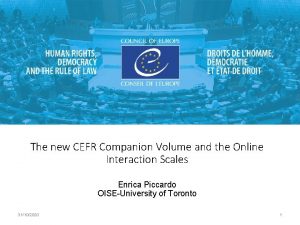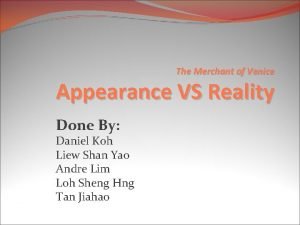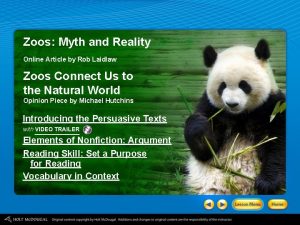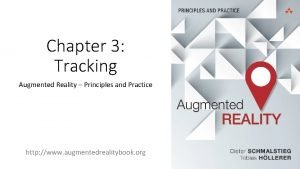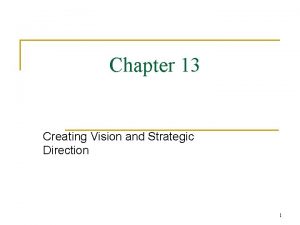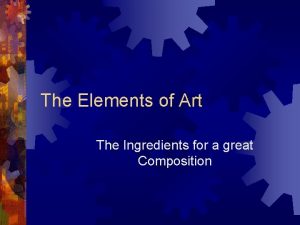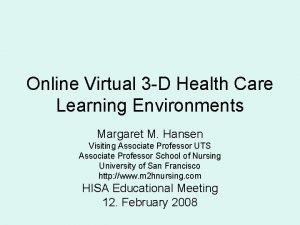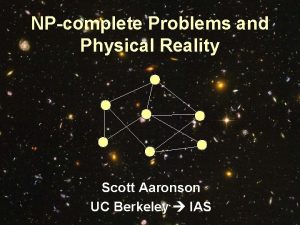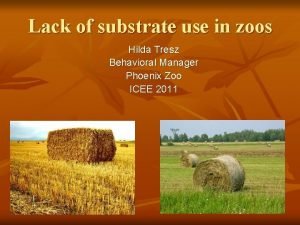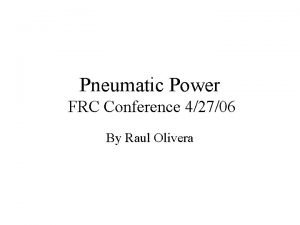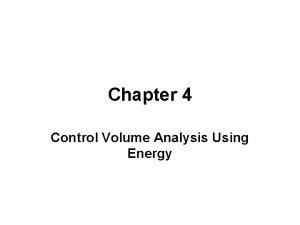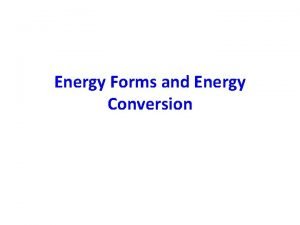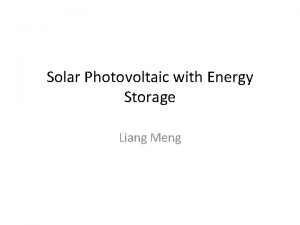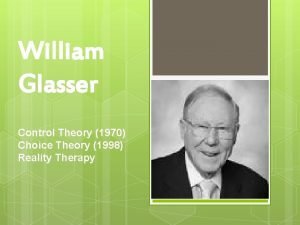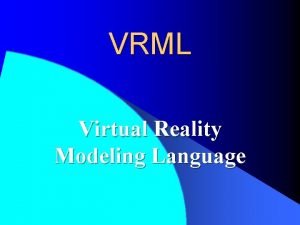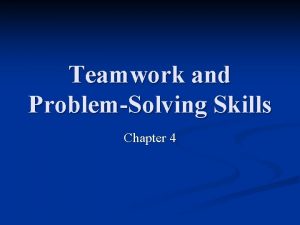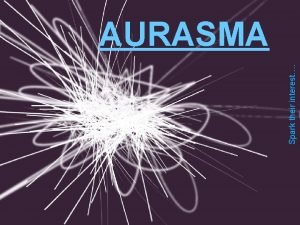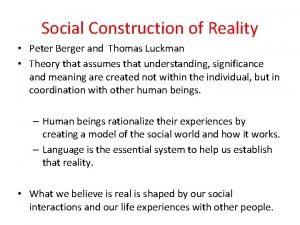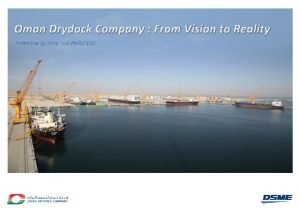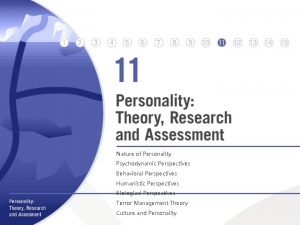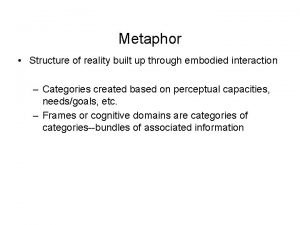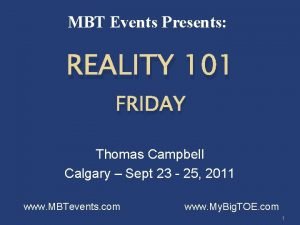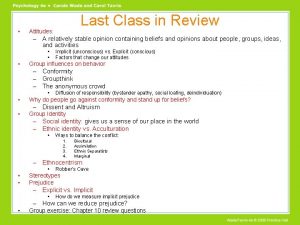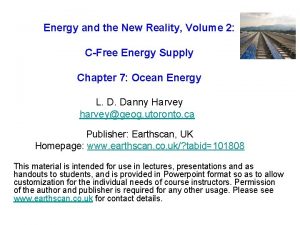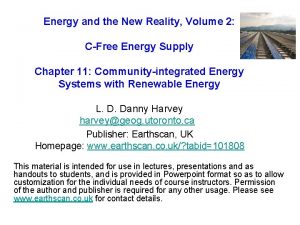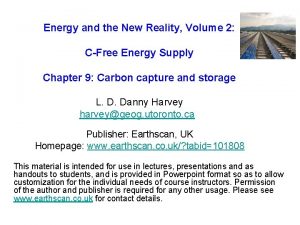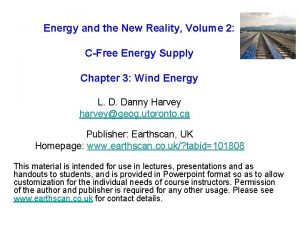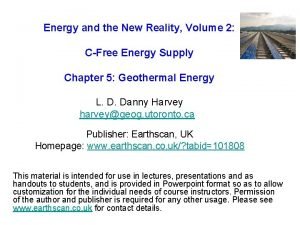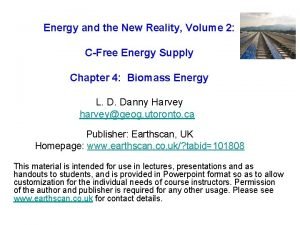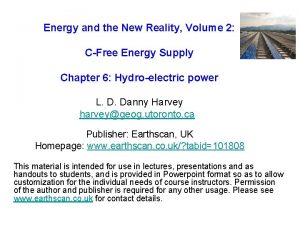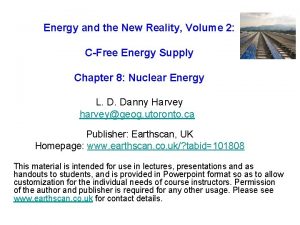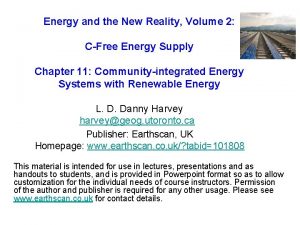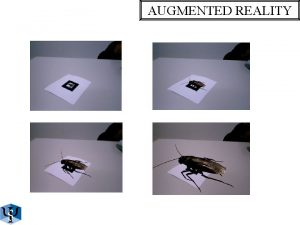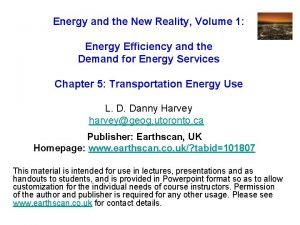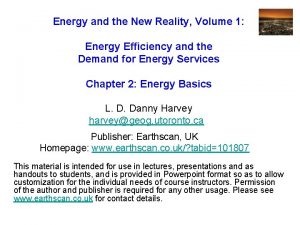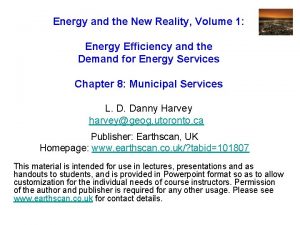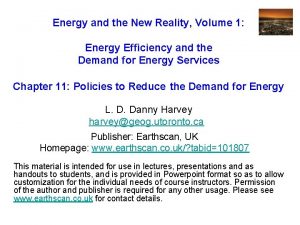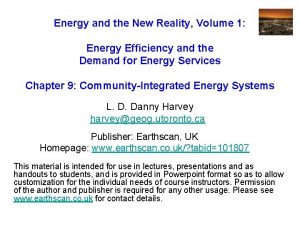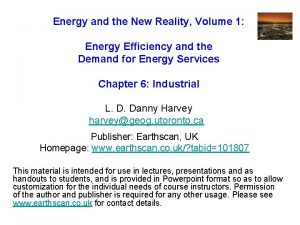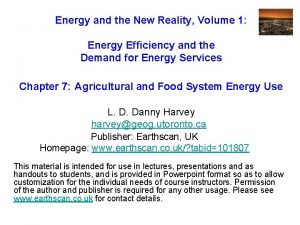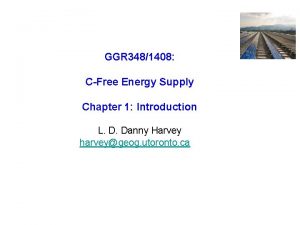Energy and the New Reality Volume 2 CFree










































































































- Slides: 106

Energy and the New Reality, Volume 2: C-Free Energy Supply Chapter 8: Nuclear Energy L. D. Danny Harvey harvey@geog. utoronto. ca Publisher: Earthscan, UK Homepage: www. earthscan. co. uk/? tabid=101808 This material is intended for use in lectures, presentations and as handouts to students, and is provided in Powerpoint format so as to allow customization for the individual needs of course instructors. Permission of the author and publisher is required for any other usage. Please see www. earthscan. co. uk for contact details.

Outline • • • Basics of nuclear physics Fuels and reactions inside a nuclear reactor Types of nuclear power reactors The nuclear fuel chain Safety Nuclear weapons and terrorism risks Cost Embodied energy and GHG emissions Operational constraints Current capacity, future scenarios

Basics of nuclear energy physics

Nuclei and isotopes • A given chemical element has a fixed number of protons in its nucleus (number of protons = number of electrons) • A variable number of neutrons is possible, resulting in different isotopes of an element • Protons and neutrons together are called nucleons • The number of protons in the nucleus is called the atomic number, while the number of nucleons is called the mass number

Superscripts and subscripts in front of the chemical symbol are used to represent the mass number and atomic number In 126 C, for example, 12 is the mass number and 6 is the atomic number. Because the element name and atomic number are redundant, it is common to just write 12 C instead of 126 C.

Forces in a nucleus • Electric force – repulsion between protons, varies with 1/distance 2 • Nuclear force – attraction between any two nucleons (even having the same charge), varies much more strongly with distance (and so is significant only over a distance ~ diameter of the nucleus) • Can overcome the electric repulsive force at distances comparable to the radius of a nucleus • Thus, neutrons, by providing extra nuclear forces, act as a glue holding the protons in the nucleus together

Neutron: proton ratio and stability of nuclei • As atomic number increases, the ratio of neutrons to protons required for stability of the nucleus increases • Nuclei with one or two less or one or two more neutrons are unstable – they eventually decay • If a heavy nucleus splits (fissions) into the nuclei of two lighter elements, it will often have too high a neutron: proton elements (depending on how the heavy nucleus splits), so the fission products will themselves often be unstable

Figure 8. 1 Neutron: proton ratios of the elements

Half lives of unstable nuclei • In a collection of unstable nuclei of a given isotope, not all the nuclei decay at once • Rather, it is observed that half of the nuclei existing at any given time will decay within a fixed length of time called the half-life • Thus, if the half life is 10 years and we start off with 1000 nuclei of a given isotope, there will be 500 left after 10 years, 250 left after 20 years, 125 left after 30 years, and so on

Kinds of particles emitted during the radioactive decay of an unstable nucleus • Alpha particles, consisting of 2 protons and 2 neutrons (as in the nucleus of He) • Beta particles (electrons or, rarely, positrons) • Neutrons When alpha particles are emitted, the nucleus drops down by two atomic numbers. When an electron beta particle is emitted, a neutron in the nucleus turns into a proton, so the nucleus moves up by one atomic number. Gamma rays (very short wavelength, energetic electromagnetic radiation) are emitted when a nucleus drops from an excited to a ground state (perhaps following absorption of a neutron)

Fission (splitting) of a nucleus • Can occur spontaneously (i. e. , with no external stimulus) • Can also occur as a result of the absorption of a highenergy neutron – such nuclei are said to be fissionable • Can even occur (with some probability) when a neutron of arbitrarily low energy strikes the nucleus – such nuclei are said to fissile • When fission occurs, additional neutrons are released that can then sustain a fission chain reaction (and further neutrons will be released when the fission products themselves decay) • Some nuclei can absorb neutrons but without splitting – such nuclei are said to be fertile

Fuels (or potential fuels) and decay reactions in a nuclear power reactor • Uranium (the overwhelmingly used fuel) • Plutonium (from recycling of spent fuel) • Thorium (usable in principle, has been demonstrated in the US)

Natural Uranium • • 0. 0055% U-234 (234 U) 0. 7205% U-235 99. 275% U-238 All three isotopes are radioactive but with extremely long half-lives Note: The above percentages are in terms of numbers of atoms (atom%). When speaking of enrichment, percentages are given in terms of mass (mass%). 0. 72 atom% (U-235)= 0. 71 mass%.

U-235 is fissile, and a sample reaction is 235 U + n → 236 U → 92 Kr + 141 Ba + 3 n The fission products (92 Kr and 141 Ba here) and neutrons travel at high velocity, adding some of their kinetic energy to the atoms or molecules of the material through which they travel, heating it Note that, in the above, 1 neutron is absorbed and 3 are emitted. If one of the 3 that are emitted is subsequently absorbed by another 235 U, the reaction will be self sustaining.

Figure 8. 2: Fission products of U-235

U-238 is fertile, and the reactions that occur are 238 U + n → 239 U → 239 Np + ß 239 Np → 239 Pu + ß Pu-239 is both fissile and fertile – it can either absorb another neutron (followed by emission of a beta particle, just like 238 U above), or it can split into two lighter elements (with a half life of 24, 000 years) and emit more neutrons as it splits. The absorption of a neutron by 238 U is the first in a sequence of transmutation reactions, shown in the next figure.

Figure 8. 3. Transmutation reactions beginning with U-238. Source: Modified from Wilson (1996, in The Nuclear Fuel Cycle, From Ore to Waste, Oxford University Press, Oxford )

To sum up, the reactions occurring inside a nuclear reactor are primarily: • Absorption of neutrons by 235 U, producing 236 U that then fissions and releases further neutrons • Absorption of some of the above neutrons by 238 U, producing 239 Np and 239 Pu through the sequential emission of two beta particles (electrons) • Transmutation of 239 Pu into successively heavier elements (the transuranic elements) through absorption of neutrons and emission of beta particles

Thorium as a fuel • Thorium is fertile, meaning that it can absorb neutrons without splitting (like U-238) • It must be used in combination with U-235 or P -239, which serves as the neutron source • The end result is to produce U-233 (which does not occur naturally), which can be easily separated from the spent fuel and fed into another reactor as a fuel in a closed cycle • This would increase the energy that can be derived from a tonne of mined U by 85% compared to the usual once-through use of uranium • Significant new technologies would need to be developed to use the uranium-thorium cycle

Sustaining nuclear chain reactions • Neutrons released by fission of U-235 after it absorbs a neutron move so fast that they have little chance of being absorbed by another U-235 (at least one neutron must be absorbed to sustain the process) • Thus, the neutrons must be slowed down using a moderator (water, heavy water, or graphite) – which absorbs energy from the neutrons without (ideally) absorbing the neutrons

Stabilizing nuclear chain reactions • For the reaction not to grow exponentially out of control, exactly one neutron from each fission of U-235 must cause another fission • This ratio is maintained by inserting control rods between the uranium fuel rods – the more that are inserted, the more neutrons that are absorbed before they can cause another fission

Thermal reactors • Neutrons that have been slowed down with a moderator are called thermal neutrons, and reactors using them are called thermal reactors • Those that use water as a moderator require that the uranium fuel (which is mostly U-238) be enriched in the fissile isotope U-235 (from about 0. 7% to 3 -4%). These are called light-water reactors • Reactors that use heavy water as a moderator (namely, the CANDU reactor) do not require enriched uranium. These are called heavy-water reactors.

Fast and fast breeder reactors • Neutrons that have not been slowed down are called fast neutrons. They can still be used if the reactor has a high enough density of fissile material. This requires fuelling a reactor with U 233, U-235, or Pu-239. These reactors are called fast reactors. • Pu-239 is a natural choice, since it is produced anyway in thermal reactors • If the Pu-239 content exceeds 10 -20%, more Pu 239 will be created through absorption of neutrons by U-238 than is consumed during the fission that releases the neutrons, so these reactors are called fast breeder reactors

Fast and fast breeder reactors (continued) • By repeatedly cycling nuclear fuel through fast breeder reactors, almost all of the U-238 in uranium (which accounts for > 99% of U) can be used as a fuel. Otherwise, only the U-235 (0. 72%) serves as a fuel • The problem – Pu is ideal for making nuclear weapons. Vast amounts (1000 s of tonnes) would need to be separated from spent fuel for recycling. Only 1 -2 kg are needed to make a crude bomb.

The elements produced with atomic number beyond uranium are called transuranic elements. Each of them is unstable and will eventually fission into lighter elements. Uranium and the transuranic elements, along with thorium, are referred to as actinides (they form a special series in the periodic table after the element actinium)

Measures of nuclear radioactivity • Becquerel (Bq) – 1 Bq = a rate of one decay per second • Curie (Ci) – the rate of decay of one gram of radium 1 Ci = 3. 7 x 1010 Bq • Gray (J/kg) or rad (100 s of erg/gm) – amount of energy deposited per unit mass of living tissue • Sievert (Sv) or rem – the energy deposited (grays or rads) times a factor that accounts for the different amounts of damage caused by different kinds of radiation

Sources of nuclear radiation: • Emission of beta particles during the transmutation of an actinide to an element with a higher atomic number (as in Fig. 8. 3) • Emission of neutrons during the fission of an actinide • The fission products themselves, which are released with high velocity and are large, so they are quite damaging • Emission of beta particles during the eventual decay of the fission products themselves • Emission of alpha and beta particles produced by four different radioactive decay chains that proceed spontaneously without the absorption of a neutron

Fission products of concern • Iodine-131, 8 -day half life, becomes concentrated in milk, absorbed by thyroid gland. Of greatest concern for first few weeks after a potential nuclear accident • Strontium-90, 29 -year half life, mimics calcium, becomes concentrated in bones • Cesium-137, 30 -year half life, 6% of fission products, mimics potassium, distributed throughout body

Radioactive decay chains • • Thorium series (Th-232 to Pb-208) Uranium series (U-238 to Pb-206) Actinium series (Pu-239 to Pb-207) Neptunium series (Pu-241 to Tl-205) The uranium series is shown in Fig 8. 4

Figure 8. 4 a Uranium series radioactive decay chain

Figure 8. 6 Sources of radioactivity from spent LWR fuel Source: MIT (2003, The Future of Nuclear Power: An Interdisciplinary MIT Study)

Partial summary so far: • Heat is produced inside a nuclear reactor from collisions of energetic particles produced by radioactive decay with the atoms of the material forming the reactor, or by the absorption of gamma rays • The kinds of radioactive decay are - the lighter nuclei produced by fission of U-235 (the predominant fissioning material) or by fission of transuranic elements (produced by neutron absorption) - beta particles emitted during the decay of transuranic elements that build up (mostly plutonium) - beta particles from the decay of the fission products themselves - gamma rays emitted following neutron capture by U 235, U-238, or the transuranic elements

Once the fuel has been removed from a nuclear reactor, • The reactions involving absorption of neutrons by 235 U and 238 U largely cease, as does the production of transuranic elements • The sources of radioactivity in spent nuclear fuel are -during the first year, the decay of fission products, with those having half lives of hours to days -one year after removal, the radioactivity has dropped to 1. 3% of that at the time of removal, and is dominated by the decay of fission products with half lives of around 30 years (primarily Sr-90 and Cs-137) - thereafter, the decay of transuranic elements (especially Am-241, Pu-240 and Pu-239) dominates (until 100, 000 years after removal) -finally, radioactivity from the U and Np series (which initially increases over time) dominates

Nuclear Power Plant Reactor Technologies

Nuclear Reactor Technologies • Boiling-water reactor (a LWR, thermal reactor) • Pressurized-water reactor (another LWR, thermal reactor) • CANDU HWR (also a thermal reactor) • High-temperature gas-cooled reactor (HTGR)

Figure 8. 7 Overview of nuclear powerplant technologies Source: van Leeuwen (2007, Nuclear Power- The Energy Balance, Ceedata Consultancy, Chaarn, Netherlands, www. stormsmith. nl )

Figure 8. 8 a Boiling-water light-water reactor Source: Wolfson (2003, Nuclear Choices: A Citizen’s Guide to Nuclear Technology, MIT Press, Cambridge)

Figure 8. 8 b Pressurized-water light-water reactor Source: Wolfson (2003, Nuclear Choices: A Citizen’s Guide to Nuclear Technology, MIT Press, Cambridge)

Figure 8. 8 c Liquid-metal fast breeder reactor Source: Wolfson (2003, Nuclear Choices: A Citizen’s Guide to Nuclear Technology, MIT Press, Cambridge)

Note: • The High Temperature Gas-Cooled Reactor (HTGR) uses uranium enriched to 93% U-235 (making it weapons-grade fuel), uses He as a coolant, and uses graphite (which is flammable) as a reactor. It has had mixed performance but is being reconsidered as a Generation IV reactor (see next slide). • The liquid-metal fast breeder reactor uses liquid sodium as a coolant, but sodium burns spontaneously on contact with air and reacts violently with water. Several were built but most have been shut down due to difficulties.

Nuclear technology generations • Generation I: still a few in operation • Generation II: accounts for most of today’s reactors, based on military research of the 1940 s and 1950 s • Generation III: about 20 different designs are under development. Mostly incremental improvements from Generation II, but can still take decades to develop • Generation IV: 6 advanced concepts under development, most involving a closed cycle with reprocessing of spent fuel [on site] to separate and use plutonium. These exist only on paper at present, and would likely take 2 -3 decades to develop.

The Nuclear Fuel Chain

Steps in the Nuclear Fuel Chain • Mining and milling of primary uranium, production of tailings waste • Enrichment of primary uranium, done by converting U to gaseous form and using centrifuges or membranes under pressure, creating a stream of depleted uranium (DU) waste. About 7 kg of natural uranium (0. 7% U-235) are needed to produce 1 kg of U enriched to 3. 6% U 235, with U-235 depleted to 0. 2% in the DU stream • Use of nuclear fuel (the burn-up is the amount of heat produced per kg of fuel) • Possible reprocessing of spent fuel, generating lots of liquid and gaseous wastes • Isolation (“disposal”) of spent fuel and/or reprocessing of wastes

Fuel chain step 1: Separation of uranium from ores • Uranium occurs as oxides in uranium ores • The proportion of uranium ores containing U is quite small (ranging from 0. 03% to 18. 0% in commercial operations, but averaging only 0. 2%) • The mass of ore that must be processed per unit mass of uranium, and the associated rock waste, is given by the reciprocal of the ore grade • Thus, for 0. 2% grade ore, 500 tonnes of ore must be processed to obtain 1 tonne of U • However, in open-pit mines, up to 40 tonnes of rock might be excavated per tonne of ore that is extracted

• The recovered ore is crushed and leached with sulfuric acid or alkaline fluids in order to separate out the uranium • The final product is called yellow-cake (U 3 O 8) • 85% of the radionuclides in the original ore end up in the wastes, which are called tailings. • Management of the tailings (due to their radioactivity and toxicity) will need to continue essentially forever (several 100, 000 years)

Figure 8. 9: World uranium extraction techniques in 2007 Source: NEA/IAEA (2008, Uranium 2007: Resources, Production and Demand, OECD Publishing, Paris)

Figure 8. 10: Yellowcake – U 3 O 8, produced from milling of the U ore followed by leaching from the crushed ore. Source: www. wise-uranium. org

Fuel chain step 2: Enrichment of uranium in U-235 • Light-water reactors require the uranium fuel to be enriched in U-235 (from 0. 7% in natural uranium to 3 -5%) • This requires converting the uranium to a gaseous form (UF 6), and using either gaseous diffusion through membranes under pressure, or centrifuges, to create 2 streams – one enriched in U-235 and the other depleted in U-235 • The depleted uranium has to be stored somewhere essentially forever

Figure 8. 11 Waste canisters containing depleted uranium, produced during the enrichment of natural uranium in U-235 Source: www. wise-uranium. org

Fuel chain step 3: Use of U fuel • The various high-energy particles produced from the radioactive decay of the fuel (along with some gamma radiation) impart kinetic energy at the molecular scale to the surrounding materials through collisions with the atoms of the surrounding materials – that is, they heat it up • The amount of heat produced per unit mass of fuel is called the fuel burn-up. • Burn-ups have increased from about 20 GWd (gigawatt-days) per tonne in the 1970 s to an average today of 45 GWd/t in BWRs and 50 GWd/t in PWRs • Electricity production per tonne of fuel is given by the burn-up times thermal efficiency of the steam turbine

• Higher burn-ups require the use of more enriched uranium and use of a greater fraction of the U-235 that is in the original fuel • Increasing the U-235 enrichment from 4. 5% to 8. 3% would double the burn-up from 40 GWd/t to 80 GWd/t, reduce the consumption of uranium ores by 7%, reduce the mass of spent fuel by 50%, and increase the concentration of radionuclides in the spent fuel (increasing the heat production per unit mass)

Fuel Chain Step 4: Optional Reprocessing of spent fuel • Recycle into a LWR • Recycle into a HWR • Recycle into fast reactors or fast breeder reactors

Spent reactor fuel contains • Most of the original U-238 and perhaps 20% of the original U-235 (the U-235 may have gone from an enriched concentration of 4% down to 0. 8%) • Fission products • Plutonium and minor actinides (such as Np-237, Am-241 & Am-243, Cm-242 to Cm-248, and Cf 249 to Cf-252)

Figure 8. 12 Composition of fresh and spent nuclear fuel Source: Albright and Feiveson (1988, Annual Review of Energy 13, 239– 265)

Reprocessing • Reprocessing requires separating the U-235 and Pu-239 (which can be used as a fuel) from the spent fuel • This is done by dissolving the spent fuel in a strong acid • The fission products and minor actinides are not useful as a fuel, and are highly radioactive, so they must be removed and stored in containers that are actively cooled

Reprocessed Fuel • Consists of mixtures of oxides of U-235 and Pu, accounting for about 4. 5% of the total if fed to LWRs, along with natural or depleted uranium (from previous enrichment activities) • It is therefore called Mixed Oxide (MOX) fuel • About 5 -6 kg of spent fuel must be processed to make 1 kg of MOX

Reprocessed Fuel (continued) • There will be a deficit in U-235 in the MOX, which can be made up either by adding Pu from dismantled nuclear weapons (thereby providing a way of getting rid of Pu if and as the world disarms), or by using the spent fuel from more than one LWR to provide the fuel for the equivalent of one LWR running on 100% reprocessed fuel • In practice, a LWR would take only 1/3 MOX and 2/3 fresh fuel • The net result is that using reprocessed fuel in LWRs extends the uranium supply by 20 -25%

Other reprocessing options: • Use spent LWR fuel directly in a CANDU HWR • Recycle in a fast reactor that is designed to exactly consume the amount of Pu and other transuranic elements produced from a LWR, leaving only the fission products (all of which have half lives of 30 years or less) • Recycle in a fast breeder reactor, having a net production of Pu (from U-238) that can be fed as fuel to other reactors

Status of Reprocessing Today • US reprocessing shut down due to concerns about proliferation of nuclear weapons, especially after India made a bomb from extracted Pu in 1974 • Japanese reprocessing shut down in 1995 after a severe sodium fire; might be restarted • UK reprocessing shut down in 2005 after discovery of leakage of spent fuel dissolved in acid • France (1700 t/yr), Russia (400 t/yr), and India (275 t/yr) are the major reprocessors today • Other countries (including the US) had been reconsidering • Only 27 GW of nuclear plants out of 369 GW worldwide use some reprocessed fuel (1/3 of their total, so they are equivalent to 9 GW out of 369 running on 100% reprocessed fuel)

Fuel Chain Step 5: Decommissioning of nuclear powerplants This involves: • Removal of the spent fuel • Cleaning and decontaminating the plant as thoroughly as possible • Altering the ventilation system • Removing all ancillary equipment and buildings • Dismantling or reducing in size and removing the remaining plant parts

Decommissioning is rendered difficult and expensive because many of the plant materials will have been rendered radioactive during the operation of the plant. The radioactivity comes from activation products – nonradioactive isotopes in the plant materials that are turned into radio-active isotopes through the absorption of neutrons. Examples include Ca-41 and Cl-36 produced from Ca-40 and Cl 35 in concrete and steel. Due to this radio-activity, the no-longer used plant must site idle for some time (up to 135 years allowed in the UK, up to 60 years in the US) before decommissioning begins. In Japan, idled plants must be decommissioned within 10 years of shutting down.

Fuel Chain Step 6: Isolation (“disposal”) of nuclear waste

Categories of nuclear waste • High level – spent fuel, liquid wastes from production and possible later reprocessing of spent fuel, solids into which such liquid wastes have been converted • Transuranic or intermediate-level wastes, produced during processing of spent fuel • Low-level waste, produced during most steps of the nuclear fuel chain

Isolation Options • Reprocessing – using cycles designed to consume Pu-235 and other long-lived transuranic elements, leaving shorter-lived radioisotopes • Deep geological disposal – concerns about groundwater as climate changes • Transmutation – exceeding complex

Geological repositories rely on one of two kinds of barriers to prevent spread of radio-nuclides: • Geological barriers – as in the proposed and then withdrawn and maybe re-instated Yucca Mountain site in Nevada (the assumption had been that there would never be groundwater flow through the site during the next 1 million years) • Engineered barriers, as in the Finnish and Swedish proposals The Swedish proposal requires • a 25 t cast-iron canister for every 2 t of waste • a 5 -cm thick copper cladding around each canister • Placement of canistors 500 m below ground, packed with bentonite (a swelling clay)

Figure 8. 13. Waste flow associated with 1 GWyr of electricity production, assuming: 5: 1 waste rock/ore ratio, 0. 2% grade, enrichment to 3. 6%, 42 GWd/t. U burnup

Safety Issues • • Routine operation of nuclear power plants Terrorist attacks on nuclear power plant Military strikes on nuclear power plants Accidents at reprocessing plants (several have already occurred, and we’re hardly doing any reprocessing)

Nuclear weapons proliferation issues

There is concern both about more states acquiring nuclear weapons, and about sub-national or terrorist groups getting enough materials to make a crude nuclear bomb. There are two distinct points of risk • Enrichment of U-235 for power generation – 2/3 of the effort require to make bomb-grade uranium (90% U-235) already has to be expended just to make reactor-grade uranium (3. 5% U-235) • Separation of Pu from spent fuel (which is highly radioactive and thereby inhibits handling), thereby making it relatively safe and easy to use

Figure 8. 15: Effort (represented by Separative Work Units) to enrich uranium in U-235

Cost of nuclear electricity

Factors contributing to the cost of nuclear electricity • • Capital cost Capacity factor Fuel cost Decommissioning and long-term isolation of nuclear wastes

Capital Cost • Big unknown for complicated, new technologies, especially if not mass produced (such as Generation III or IV nuclear reactors) • Early (2000 -2005) estimates of future construction costs clustered around $2000/k. W • Many recent reactors have cost $3000 -4000/k. W • Some analysts have projected costs of $600010000/k. W

Figure 8. 16 Capital cost of nuclear power plants Source: Cooper (2009, Institute for Energy and the Environment, Vermont Law School)

Note: The preceding slide gives “overnight” capital costs. These costs • Do not include interest that accrues during the construction period (which can be up to 10 years) • Do not include inflation of component costs during the construction period (which have tended to exceed the general rate of inflation) • Do not include additional utility costs, such as the cost of upgrading the grid to accept a large new source of power Rather, overnight costs are the costs for the powerplant alone if everything could be bought at once and the plant could be constructed overnight. Final costs are typically 50 -75% greater than the overnight cost, but have been as high as double the overnight cost.

Fuel costs • Fuel is a very small contributor to the overall cost of nuclear electricity, and the cost of uranium itself is a small factor in the overall fuel cost • Thus, the price of uranium can increase greatly (due to future scarcity) with little impact on the overall cost of nuclear energy (but increased uranium cost would make more uranium economically available)

Decommissioning and long-term isolation costs • These are likely to significantly increase the overall cost of nuclear electricity • Most current assessments seem to vastly underestimate these costs • In any case, there are very few firm data available

Figure 8. 17: Estimated cost of decommissioning graphite-moderated nuclear power plants in the UK

Figure 8. 18 Cost of nuclear energy Source: Cooper (2009, Institute for Energy and the Environment, Vermont Law School)

Note: The preceding costs assume essentially zero insurance and liability costs compared to the potential cost of a nuclear accident. This is because no private investors would be prepared to accept the risk, and no insurance companying would be prepared to sell insurance, if the nuclear power plant operators would be financially responsible for the majority of the potential damage in the event of a serious accident.

Nuclear power plants have a notorious problem of large cost over-runs. Below are average amounts by which final cost exceeds initial cost estimates for various kinds of electricity powerplants: Nuclear powerplants, 117% over Hydroelectric dams, 70% over Fossil fuel powerplants, 13% over Wind farms, 8% over Solar facilities, 1. 3% over Source: Gilbert et al. (2017, Energy Policy)

EROEI and GHG Emissions

Figure 8. 19 Fraction of uranium recovered from ore as a function of the ore grade Source: van Leeuwen (2007, Nuclear Power- The Energy Balance, Ceedata Consultancy, Chaarn, Netherlands, www. stormsmith. nl )

Supplemental figure: The Escondida copper mine in Chile. Source: van Leeuwen (2007, Nuclear Power - The Energy Balance, Ceedata Consultancy, Chaarn, Netherlands, www. stormsmith. nl )

Figure 8. 20 Cross section of the proposed open-pit Olympic uranium mine Source: van Leeuwen (2007, Nuclear Power- The Energy Balance, Ceedata Consultancy, Chaarn, Netherlands, www. stormsmith. nl )

Energy Inputs Related to Nuclear Energy • Energy is required to make all of the materials that go into a nuclear powerplant (cement, steel, copper, aluminum especially) • Energy is also used during mining and milling of uranium ores, during the enrichment process, during the operation of the nuclear power plant, and later during decommissioning, possible reprocessing of spent fuel, excavation of the longterm repository for nuclear wastes, and packaging of the wastes

Energy Return Over Energy Invested (EROEI) • The EROEI can be computed based on the ratio of all the electrical energy generated to all secondary energy inputs (fuels and electricity) • Alternatively, it can be based on the primary energy saved when nuclear electricity is produced (assuming that fossil fuel electricity generated at 40% efficiency is displaced) and the total primary energy inputs • The effective efficiency in using fuels can be computed as the net electricity production (electricity produced minus all electricity inputs) divided by the fuel primary energy • The EROEI and effective efficiency drop sharply as the ore grade decreases from 0. 1% to 0. 01%.

Figure 8. 21 Published estimates of the amount of energy required to construct a 1 GW nuclear powerplant AEI=average energy intensity (KJ/$)

Figure 8. 22 Energy use over the 40 -year life of a 1 -GW LWR nuclear powerplant with a capacity factor of 0. 87

Figure 8. 23 EROEI based on secondary energy for the nuclear powerplant featured in Fig. 8. 22 (left scale) and fuel efficiency (net electrical energy generated divided by fossil fuel use) (right scale). Note: the present world average grade of ore is about 0. 2%

GHG Emissions • Wide range of estimates • Middle value is about 1/3 that of a state-of-art the natural gas combined cycle powerplant (at 60% efficiency) • Would increase with a decrease in the average grade of the ore being mined (due to greater energy use during mining and milling operations)

Nuclear Energy Today

Figure 8. 24 Nuclear Share of Electricity Source: www. iaea. org/programmes/a 2/index. html

Figure 8. 25 Growth in nuclear energy

Figure 8. 26 Nuclear powerplant capacity factors Source: WEC (2007, 2007 Survey of Energy Resources, World Energy Council, London)

Figure 8. 27 Nuclear reactor ages Source: Data from www. iaea. org/programmes/a 2/index. html

Figure 8. 28 World Uranium Resources

Potential Future Contribution of Nuclear Energy

Maintaining existing capacity • As of April 2007, 114 out of 436 nuclear power reactors in the world were more than 30 years old • Assuming the normal reactor lifetime of 40 years, 114 new reactors will be needed during the next 10 years, or an average of one every 5 weeks – just to maintain the existing capacity • The following decade, a new reactor would be needed every 22 days on average just to maintain the existing capacity

Limits on expansion • To maintain a nuclear fleet with 1000 GW capacity (about 25% of current total world electrical capacity but almost 3 times the 2007 nuclear capacity of 369 GW) would generate 20, 000 tonnes of spent fuel per year (assuming a 90% capacity factor and burn-up of 50 GWd/t), or 10, 000 tonnes of spent fuel per year (if a 100 GWd/t burn-up is achieved). • This would require the establishment of a new Yucca Mountain scale waste repository every 3. 5 to 7 years, or • Reprocessing would require 6 -12 times the current French reprocessing capacity (1700 t/yr). • Included in this would be production of 195 -264 tonnes of Pu per year

Resource Constraints • Its hard to say how much uranium might become available with large increases in the price of uranium (due to scarcity) • However, in the absence of reprocessing and use of fast breeder reactors (which pose enormous terrorism risks in today’s world), the supply would likely not be adequate for more than 100 years (and possibly much less), given a fleet of 1000 GW. • As lower grades of uranium ore are exploited, the energy cost associated with extracting and processing the ore would rise sharply (at present the nuclear lifecycle GHG emissions are about 1/3 that of a natural gas powerplant at 60% efficiency)

Figure 8. 29 Distribution of “identified” uranium resources with respect to the ore grade Source: van Leeuwen (2007, Nuclear Power- The Energy Balance, Ceedata Consultancy, Chaarn, Netherlands, www. stormsmith. nl )

Figure 8. 30 Cost of uranium vs the grade of ore supplying the uranium Source: van Leeuwen (2007, Nuclear Power- The Energy Balance, Ceedata Consultancy, Chaarn, Netherlands, www. stormsmith. nl )

Concluding Thoughts

Given that nuclear energy could supply 25% of our electricity needs for at most 100 years, after which we’ll have to find alternatives anyway, and that the next 100, 000 years or more of generations will be burdened with dangerous wastes, can we ethically justify such a short fling with nuclear energy now?

In any case, it is not possible to ramp up nuclear energy fast enough to make a noticeable difference to our GHG emissions before 2050. This is not soon enough – large reductions are needed during the next 30 years in order to significantly reduce the risk of or extent of the foreseeable global ecological catastrophe
 Energy energy transfer and general energy analysis
Energy energy transfer and general energy analysis Energy energy transfer and general energy analysis
Energy energy transfer and general energy analysis End-diastolic volume vs end-systolic volume
End-diastolic volume vs end-systolic volume End-diastolic volume vs end-systolic volume
End-diastolic volume vs end-systolic volume Volume of solute divided by volume of solution * 100
Volume of solute divided by volume of solution * 100 Lung capacity
Lung capacity Volume kerucut = .....x volume tabung *
Volume kerucut = .....x volume tabung * Example of large volume parenterals
Example of large volume parenterals Hình ảnh bộ gõ cơ thể búng tay
Hình ảnh bộ gõ cơ thể búng tay Frameset trong html5
Frameset trong html5 Bổ thể
Bổ thể Tỉ lệ cơ thể trẻ em
Tỉ lệ cơ thể trẻ em Gấu đi như thế nào
Gấu đi như thế nào Tư thế worms-breton
Tư thế worms-breton Chúa yêu trần thế alleluia
Chúa yêu trần thế alleluia Môn thể thao bắt đầu bằng từ đua
Môn thể thao bắt đầu bằng từ đua Thế nào là hệ số cao nhất
Thế nào là hệ số cao nhất Các châu lục và đại dương trên thế giới
Các châu lục và đại dương trên thế giới Công thức tính thế năng
Công thức tính thế năng Trời xanh đây là của chúng ta thể thơ
Trời xanh đây là của chúng ta thể thơ Mật thư anh em như thể tay chân
Mật thư anh em như thể tay chân 101012 bằng
101012 bằng độ dài liên kết
độ dài liên kết Các châu lục và đại dương trên thế giới
Các châu lục và đại dương trên thế giới Thơ thất ngôn tứ tuyệt đường luật
Thơ thất ngôn tứ tuyệt đường luật Quá trình desamine hóa có thể tạo ra
Quá trình desamine hóa có thể tạo ra Một số thể thơ truyền thống
Một số thể thơ truyền thống Cái miệng nó xinh thế chỉ nói điều hay thôi
Cái miệng nó xinh thế chỉ nói điều hay thôi Vẽ hình chiếu vuông góc của vật thể sau
Vẽ hình chiếu vuông góc của vật thể sau Thế nào là sự mỏi cơ
Thế nào là sự mỏi cơ đặc điểm cơ thể của người tối cổ
đặc điểm cơ thể của người tối cổ V. c c
V. c c Vẽ hình chiếu đứng bằng cạnh của vật thể
Vẽ hình chiếu đứng bằng cạnh của vật thể Tia chieu sa te
Tia chieu sa te Thẻ vin
Thẻ vin đại từ thay thế
đại từ thay thế điện thế nghỉ
điện thế nghỉ Tư thế ngồi viết
Tư thế ngồi viết Diễn thế sinh thái là
Diễn thế sinh thái là Dot
Dot Số.nguyên tố
Số.nguyên tố Tư thế ngồi viết
Tư thế ngồi viết Lời thề hippocrates
Lời thề hippocrates Thiếu nhi thế giới liên hoan
Thiếu nhi thế giới liên hoan ưu thế lai là gì
ưu thế lai là gì Khi nào hổ mẹ dạy hổ con săn mồi
Khi nào hổ mẹ dạy hổ con săn mồi Khi nào hổ con có thể sống độc lập
Khi nào hổ con có thể sống độc lập Sơ đồ cơ thể người
Sơ đồ cơ thể người Từ ngữ thể hiện lòng nhân hậu
Từ ngữ thể hiện lòng nhân hậu Thế nào là mạng điện lắp đặt kiểu nổi
Thế nào là mạng điện lắp đặt kiểu nổi New york, new jersey, pennsylvania, and delaware
New york, new jersey, pennsylvania, and delaware Fresh oil new wine
Fresh oil new wine Weaknesses and strengths of the articles of confederation
Weaknesses and strengths of the articles of confederation New marketing realities
New marketing realities New classical macroeconomics
New classical macroeconomics Chapter 16 toward a new heaven and a new earth
Chapter 16 toward a new heaven and a new earth Leanne keene french ambassador arrives from paris
Leanne keene french ambassador arrives from paris New classical and new keynesian macroeconomics
New classical and new keynesian macroeconomics Cefr companion volume
Cefr companion volume Output devices in virtual reality
Output devices in virtual reality Appearance vs reality the merchant of venice
Appearance vs reality the merchant of venice Zoos connect us to the natural world claim
Zoos connect us to the natural world claim What is ironic contrast
What is ironic contrast Augmented reality: principles and practice
Augmented reality: principles and practice Vision focuses on the current reality and maintaining it
Vision focuses on the current reality and maintaining it Generally restful like the horizon where the sky meets land
Generally restful like the horizon where the sky meets land Shadow reality
Shadow reality Pros and cons of virtual reality in healthcare
Pros and cons of virtual reality in healthcare Np-complete problems and physical reality
Np-complete problems and physical reality Hilda tresz
Hilda tresz Pressure x volume = energy
Pressure x volume = energy Control volume analysis using energy
Control volume analysis using energy Section 1 work and machines section 2 describing energy
Section 1 work and machines section 2 describing energy Primary energy and secondary energy
Primary energy and secondary energy What is commercial energy source
What is commercial energy source Helmholtz free energy
Helmholtz free energy Renewable energy and energy efficiency partnership
Renewable energy and energy efficiency partnership Examples of kinetic energy
Examples of kinetic energy Types of potential energy
Types of potential energy Mechanical advantage
Mechanical advantage The change in mechanical energy
The change in mechanical energy Eroei
Eroei Split speech punctuation
Split speech punctuation Marquis theatre
Marquis theatre New-old approach to creating new ventures
New-old approach to creating new ventures Njbta
Njbta Roosevelt taft wilson comparison
Roosevelt taft wilson comparison Solar panel efficieny
Solar panel efficieny Reality therapy questions
Reality therapy questions Virtual reality modeling language
Virtual reality modeling language Augmented reality big data
Augmented reality big data Gognitive
Gognitive Ultimate reality meaning in urdu
Ultimate reality meaning in urdu The process of making an expectation a reality
The process of making an expectation a reality Reactants
Reactants Studio aurasma
Studio aurasma The social construction of reality summary
The social construction of reality summary Product placement coordinator
Product placement coordinator Total behavior car
Total behavior car Religious symbols
Religious symbols Oman drydock company logo
Oman drydock company logo Ego reality principle
Ego reality principle Sad metaphor examples
Sad metaphor examples Tom campbell virtual reality
Tom campbell virtual reality Appearance v reality macbeth
Appearance v reality macbeth Ego reality principle
Ego reality principle Reality therapy questions
Reality therapy questions


























































